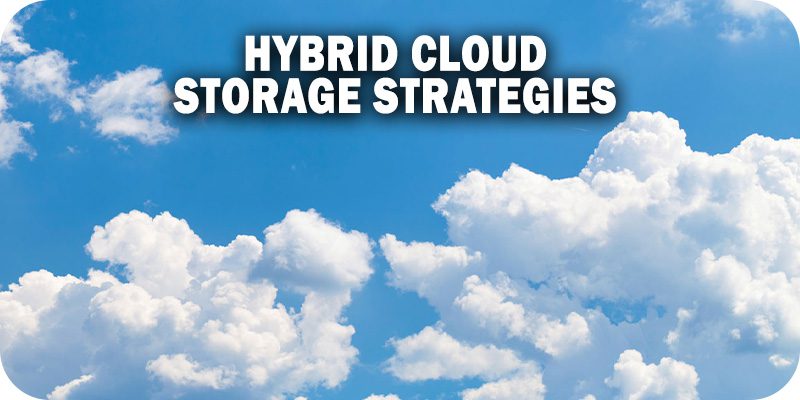
 Everybody’s jumping ship right now — or, more correctly, jumping from cloud-only strategies to hybrid strategies. This migration came to light when the Cloud Industry Forum conducted a survey and discovered the desire for seamless solutions, regardless of the type of data transformation and storage, drives 60 percent of businesses toward a hybrid cloud ecosystem (as opposed to a cloud-only strategy).
Everybody’s jumping ship right now — or, more correctly, jumping from cloud-only strategies to hybrid strategies. This migration came to light when the Cloud Industry Forum conducted a survey and discovered the desire for seamless solutions, regardless of the type of data transformation and storage, drives 60 percent of businesses toward a hybrid cloud ecosystem (as opposed to a cloud-only strategy).
Hybrid Cloud Benefits: Evergreen Flexibility and Staying Up to Date
The competition of the public clouds has been fierce, and on-premises technologies have noticed and are reemerging as a value add in conjunction with the public feature set. A hybrid cloud, which can include on-premises and public platforms, can provide reduced costs, greater agility, security, compliance, and deployment flexibility while getting the most out of existing infrastructure investments.
The rising cost of cloud and advances in cloud hybrid technologies has led many companies to choose a hybrid solution. Mordor Intelligence performed a 10-year forecast ending in 2028, and it estimated that the hybrid cloud market will grow by a compound annual growth rate of almost 22 percent. Additionally, according to Cisco’s “2022 Global Hybrid Cloud Trends Report,” 82 percent of IT leaders are shifting to hybrid cloud environments.
The studies detail the public cloud struggles to merge with new technologies that are often required for a strong enterprise data storage strategy and other business practices. That is not the only concern. Here are some other reasons you might opt for a hybrid solution over selecting a single cloud provider:
- Vendor lock-in
- Higher costs
- More control over sensitive data
- Compliance requirements
- Inflexible physical storage is required for on-premises information
- Improved business continuity
Data virtualization is a solution because it leaves data where it sits in existence. However, there are different methods for replicating it into an ingestion layer. For example, an SQL database sits on-premises. You can virtualize that data and consume it from a cloud product without moving it from that environment. It can reduce some of the efforts of cloud transformation that can occur, helping you avoid a massive migration process while you benefit from the downstream effects of cloud products.
The Pros and Cons of Hybrid: Both Sides of the Story
Integrating multiple systems can be a lot of work. But in most cases, when companies choose to stick to a cloud-only ecosystem, it’s more about familiarity and habit than efficiency and productivity. However, as these businesses expand, they tend to see a few red flags — all warning that their current cloud system is not robust enough to meet the company’s growing needs. Signs include uncontrolled cloud costs, the inability to connect with other companies because they have a hybrid system, and growing expenses.
It’s safe to say that traditional cloud-only ecosystems are getting rather long in the tooth. This begs the question: Which hybrid cloud benefits are the biggest magnets drawing companies toward this type of ecosystem?
Pro: Improved ROI
Adding a public cloud provider to your existing on-premises infrastructure allows you to expand your cloud computing capacity without increasing your data center expenses. Hybrid cloud models also open the door to the latest technologies, such as artificial intelligence and machine learning, without extending or replacing your existing infrastructure. You can speed up the development and delivery of apps by maximizing resources and increasing productivity.
Pro: Reduced Security Costs and Risk
Hybrid cloud infrastructure is a more cost-effective operation, especially in the field of security. It allows you to store all critical and sensitive data on private servers while keeping applications and less sensitive information on a public cloud. This approach also allows for effective application governance, which lets you decide where your application sits and where hybrid computing happens. As a result, it assists in improving privacy and ensuring compliance for your regulated applications. In short, using a hybrid cloud ecosystem means that you will keep premium control over all your business data as the platform strongly limits exposure to unauthorized individuals.
Pro: Fluid Innovation
A hybrid cloud platform allows your business to optimize IT performance, increase marketing, and, perhaps more critically, foster the ability to respond quickly and efficiently to changing work demands. You can also operate in an environment that makes sense for you. This gives you a natural edge over competitors who prefer cloud-only solutions.
Con: It Takes Planning to Migrate
While hopping from the cloud to a hybrid platform isn’t technically a drawback, it should be mentioned. Why? Because in the beginning, the process will require a level of planning to successfully migrate all the necessary aspects of your business to hybrid cloud storage.
Con: Training and Security Mismanagement
When people come together on a more complex platform, not everyone might have the training to deal with the new ecosystem or have the knowledge to stay on top of any security issues that might arise as the network grows. At best, this could lead to the underutilization of the hybrid cloud’s full potential and, at worst, security breaches and data leaks. Training, choosing the right network protection tool and habits, and fostering a culture of open dialogue will keep everyone on the same page.
How to Effectively Adopt a Hybrid Cloud Strategy
Ready to embrace a hybrid cloud strategy? Here’s what you should know about making the switch.
Utilize Automation & AI
When considering a hybrid cloud strategy, automation is a solution that can help with the transition and data transformation in general. You can automate scale-out and provisioning as well as deployment in private clouds, public clouds, and edge locations. In data observability, for example, automation and AI effectively make migration and abstraction easier by helping identify, tag, and put governorship in place around data.
Migrate in Small Increments
If your data system is very simplistic, doing a full swap in a day is possible. However, it’s generally advised to migrate to a hybrid system via small steps. Focus on securing one aspect of your business on the new network and then make sure it’s functional before moving on to the next. This doesn’t have to be stressful; automation solutions can help with the transition process.
Governance & Observability are Key
You need better monitoring if you have more systems. When you have more pieces where data sits, you need to have that identified and documented in a glossary and dictionary. You need good lineage when there are more transformation components because there are more stages through an ETL.
All of these things become paramount with the complexity of the system in order to receive all the security benefits, including cost savings, vendor lock-in, and control.
At the end of the day, a hybrid cloud represents an incredibly flexible environment. You can add what works for you and create a tailor-made ecosystem that supports your business’s continued security, productivity, and growth. This fluid ability to adapt quickly to new technology, growth, and demand is what sets it apart from the traditional cloud.

